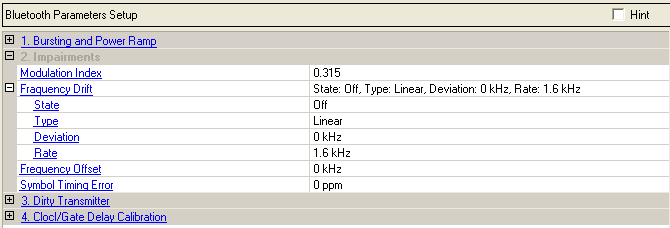

Range: 0.28 to 0.4
Default: 0.315
Specify the modulation index, which is the ratio of peak-to-peak frequency deviation to the bit rate. Modifying this parameter impairs the peak-to-peak frequency deviation only.
Click  box to specify the frequency drift impairment. This impairment
adds a dynamic error to the transmission frequency. It is used to simulate
the frequency drift impairment repeats at the beginning of each timeslot,
and occurs across a period of time equal to the duration of the packet.
box to specify the frequency drift impairment. This impairment
adds a dynamic error to the transmission frequency. It is used to simulate
the frequency drift impairment repeats at the beginning of each timeslot,
and occurs across a period of time equal to the duration of the packet.
Choice: On | Off
Default: Off
Double-click or use the drop-down menu to enable or disable the frequency drift impairment applied to the packet.
Choice: Linear | Sine
Default: Linear
Double-click or use the drop-down menu to select the type of frequency drift applied to the packet. The two different carrier frequency drift types that are available in the menu are linear and sine. The figures below illustrate the carrier frequency drift impairment for a single-slot packet. This concept can be extended to multi-slot packets as well. The maximum frequency drift deviation is user defined.
|
Figure 1. Linear frequency drift impairment |
|
|
Figure 2. Sinusoidal carrier frequency drift impairment |
|
Range: -100 to 100kHz
Default: 0 kHz
Enter the maximum deviation of frequency drift impairment. Since packets are slightly shorter than the number of timeslots they occupy, they are not fully impaired by the second half of the drift cycle. Therefore, it is recommended you test separate positive and negative drift impairment cases by changing the drift deviation setting (for example, 25 kHz and -25 kHz).
Choice: 1.6kHz | 500Hz | 300Hz | 10kHz
Default: 1.6kHz
Double-click or use the drop-down menu to select the frequency drift rate.
Range: -100 to 100kHz
Default: 0kHz
Enter the static offset for the carrier frequency. This impairment adds a static error to the transmission frequency. It is used to simulate a Bluetooth device transmitting at a frequency slightly offset from the specified carrier.
Range: -50 to 50ppm
Default: 0ppm
Enter the shift of standard symbol rate for transmission. This impairment varies the symbol rate of the Bluetooth signal. Adding this impairment adjusts the standard one Msymbol/second rate by the set amount.